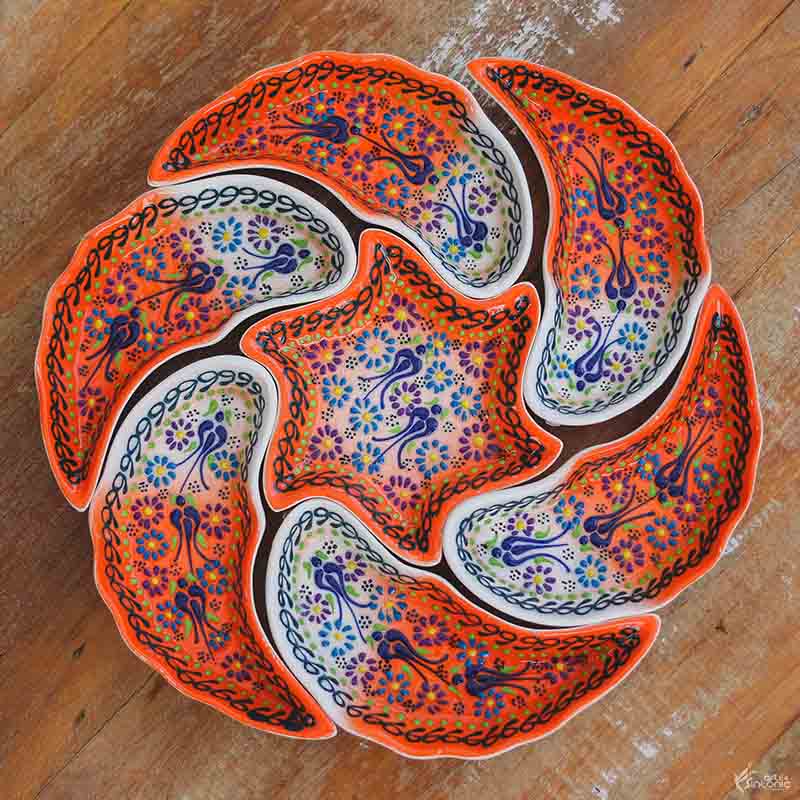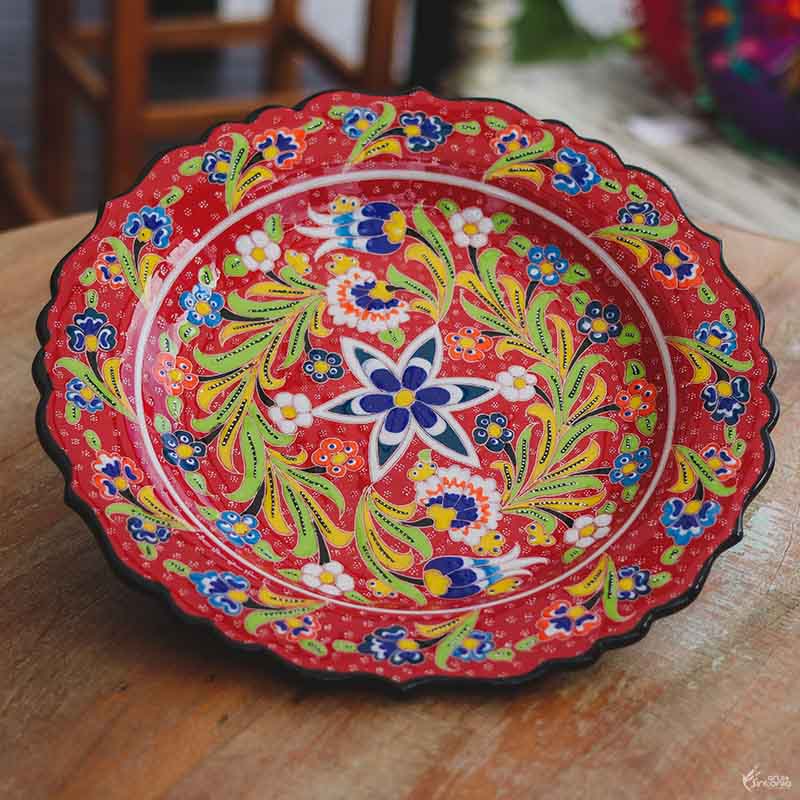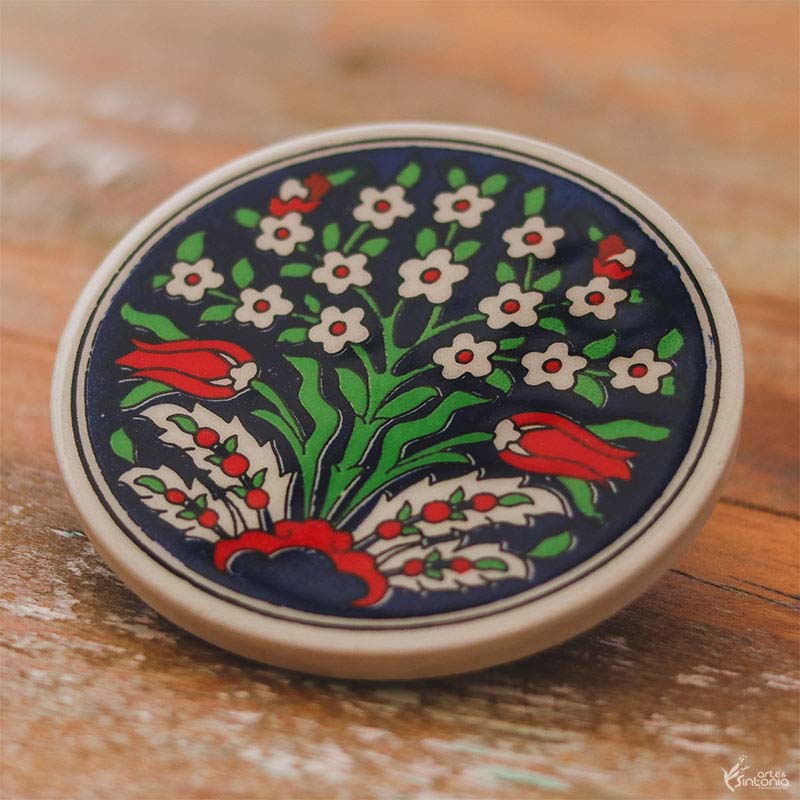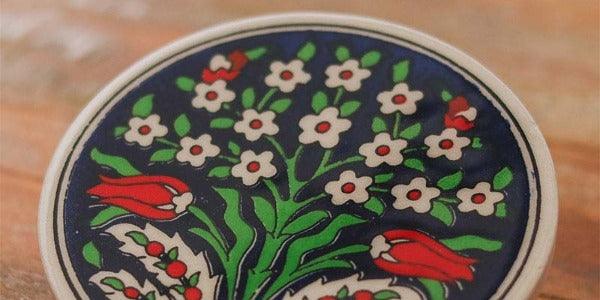Inspired by the organic lines of Chinese porcelain paintings, Turkish floral ceramics gained prestige during the Ottoman Empire, between the 15th and 17th centuries. The classic floral designs emblazoned with decorative objects and historic Iznik tiles have converted the turkish handmade ceramics into authentic relics of Islamic art, which even today motivate modern dinner sets.
Centered on motifs ( motifs ), that is, on the combination of flowers, leaves, ornamental and geometric shapes, Turkish ceramic patterns are developed in symmetry and when concentric they form elaborate mandalas . Stylish artistic paintings color plates , bowls , snacks , coasters and placemats, displaying the richness of Turkish culture in table decoration.
Iznik pottery: from decorated tiles to household items

Turkish Iznik ceramics are inspired by the high quality of Chinese porcelain.
Located in the province of Bursa, northwest region of Turkey , Iznik (historic Nicaea), became an important Turkish cultural center with outstanding production of decorated ceramics during the 9th century.
The distinctive style of decorative arts, tableware and decorated tiles in palaces, mosques, mausoleums, among others, expressed not only the luxury of the Ottoman sultanate, but also the greatness and relevance of Turkish art despite the influences of ancient domains such as Greeks, Romans , Byzantines, Seljuks.
His artistic styles were assimilated into different types of art, but that didn't stop Iznik from shining in his own right. Productions that displayed Turkish technical excellence, achieved by combining high quality and refined aesthetics – both in the paintings and in the relief ceramics itself – were called chini , in reference to the excellence of Chinese ceramic art .
Types of floral painting on Turkish pottery

The Hatayi floral motif is the most common on utilitarian objects and dinnerware.
With its own well-defined aesthetics, the Ottoman illustration in floral composition present in Iznik handcrafted ceramics varies in three basic motifs: Rumi , Minhani and Hatayi . The first, Rumi , is the most frequent in tableware paintings and integrates floral patterns with ornamental elements such as arabesques. It is an extremely detailed organic motif and favors symmetry on the surfaces following the rapport format, in “mirrored” repetition.
The Munhani , in turn, is a Seljuk heritage. It constitutes patterns that connect flowers and geometric shapes, especially the concentric ones, recalling the mandala aesthetic. Hatayi , the most relevant in dinnerware sets, expresses its personality by coordinating large and stylized florals between figures and representations.
The colors, shapes and style composition of this Iznik motif are Chinese-inspired. And it is especially found in the decoration of dishes, elevating them to the status of a work of art while also converting them into elegant alternatives to the gallery wall .
Flowers and representations in Islamic art from Iznik

Carnations, tulips and hyacinths are the most represented Iznik flowers in Turkish ceramics.
Floral designs stood out in the 15th century, displaying elegance even in their simplest aspect, since grandeur is an intrinsic characteristic of the Islamic art of polychrome ceramics . They have elongated leaves, open and bud roses, tulips, daffodils, carnations, chamomile, hyacinths, lilies, artichokes, pomegranates, vines and cypresses as the main naturalistic elements.
Some symbolic motifs such as clouds are inserted in different ways in the patterns to connect or limit colors and designs in the composition, as well as to initiate branches and flower stalks, to take the design out of monotony or to create harmony. When wavy and elongated, similar to leaves, they are called çintamani and usually accompany a set of three points, the timuçin , a symbol of power.
Another detail with symbolic representation is the crochet, a kind of arabesque or ornamentation that acts as an auxiliary element, complementing the design with balance and promoting more delicacy.
Iznik motif on modern decorative objects

The floral designs of decorated ceramics from Turkey are inspired by the style of Kara Memi.
Modern Turkish ceramics are influenced by the artistic line of Kara Memi developed in the sultanate of Suleiman I and motivated by the 14th century Ottoman gardens – considered spaces for spirituality and intellect. The style is called Quatre Fleurs , since it has four protagonist flowers: tulip, carnation, hyacinth and rose.
Each flower imprints a special meaning on the decorated pottery , in addition to being an outstanding focal point for the wall. Tulips, for example, are amulets and mystical symbols; while carnations demonstrate power and renewal. Hyacinths symbolize generosity and suggest reward; already roses evidence the divine manifestation.
These floral paintings that enrich plates , bowls , snack holders , cup holders The pot and pan maintain the renowned symmetrical pattern with an intense color palette, inspired by gemstones such as sapphire blue, emerald green and ruby red.
The value of Turkish art in home decor

Ottoman Turkish florals transcend the decorative ideal and show the value of a cultural art.
Through decorative ceramics, Turkish artisans enhance the cultural value that Islamic floral art represents. After all, the presence of flowers in the most varied ceramic objects transcends the decorative ideal, giving it a special understanding connected with spiritual beliefs. Since the symmetry comes from the notion of cosmic balance ( mizan ) manifested in the Qur'an.
The function of the pieces as utilitarian objects gains prominence through the narratives that surround each design, demonstrating the greatness and complexity of Turkish florals for the history of the country. They add style to home decor, especially wall decor , and are easily collectible.
Turkey dining sets have this valuable essence and transform the simplest receptions into true art exhibitions. The riot of colors on the tableware is revealed as the meal is consumed, taking the monotony out of the moment to show that true Ottoman beauty is revealed in the details.
Be enchanted with Turkish ceramics from our online store !
Namaste!
Milene Sousa – Art & Tune










